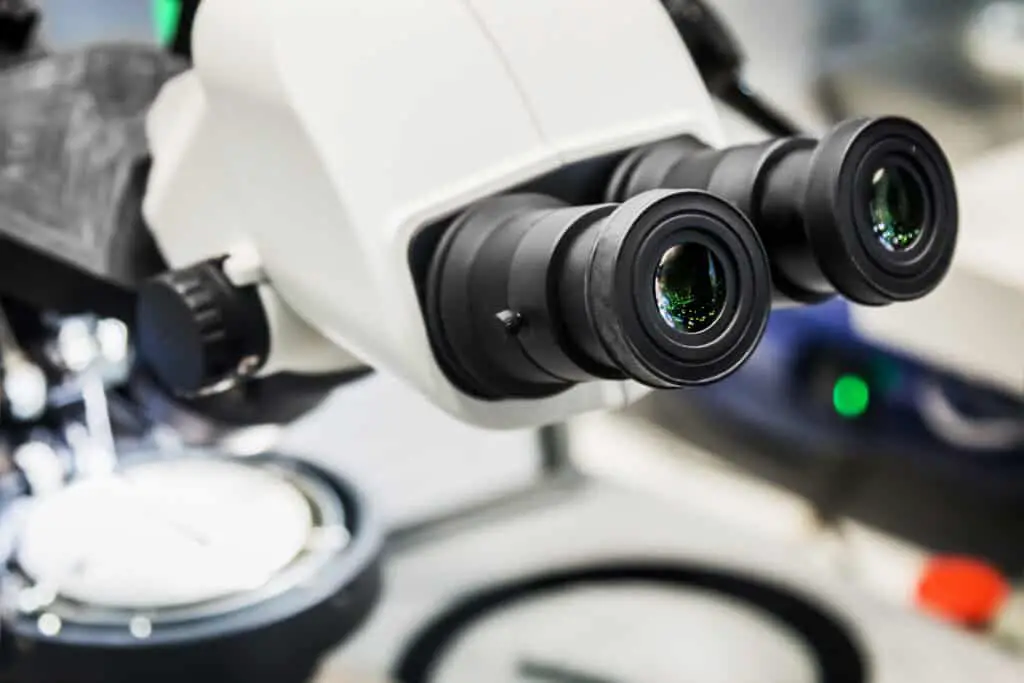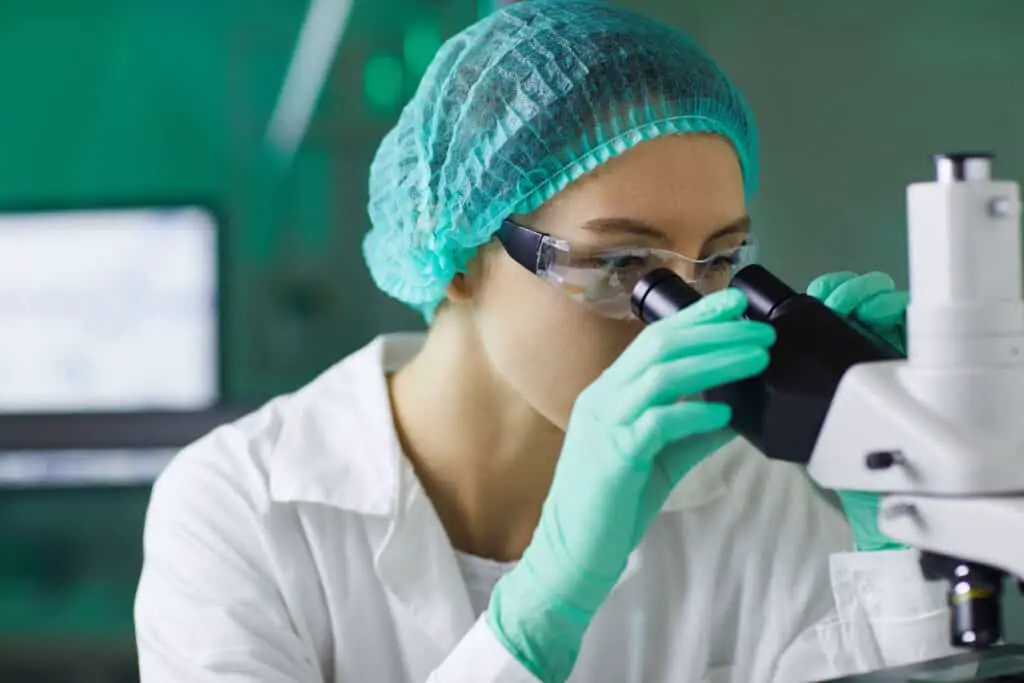If you wear glasses or contacts and you are concerned that they may be affecting what you are seeing under the microscope you’re not alone. I had this concern when I first got into microscopy.
If you wear eyeglasses to correct farsightedness or nearsightedness you do not need to wear your glasses during observation under the microscope. As you adjust the coarse and fine adjustment knobs to bring the microscope into focus, the object will appear clear even without glasses because you are adjusting the microscope relative to your natural eyesight. However if you do want to wear glasses you can opt to leave them on, just make sure you adjust the interpupillary distance before observation.
The decision on whether or not to wear glasses during observation is a matter of preference but there are other vision related things to take into consideration if you work with microscopes frequently or plan to in the future.
Should I Wear PPE?
If you are a hobbyist or enthusiast the short answer is probably not. However it depends on the types of specimens or chemical compounds you are working with.
Working in a lab can be dangerous, but only if you are not careful and do not follow rules. For instance, wearing personal protective equipment is one of the rules you need to follow. Doing so will protect you from any mistakes made in a lab.
PPE you should wear includes:
- Glasses, goggles, and/or eye shield
- Lab coat, disposable scrubs, apron
- Gloves (rubber or latex)
- Closed-toe shoes
- Mask, face shield
Depending on what you are working on, it may not be required for you to wear all of the different PPE. You might not need gloves some days, and other days you may not need to wear a mask. All of this is completely dependant on your work.
It is a good idea to always wear some form of PPE when working in a lab. In fact, you may not be allowed into a lab without having PPE on. There is a lot of glass in labs from the beakers, flasks, funnels, vials, graduated cylinders, and more. If one of these glass objects fell in a lab, it would be dangerous to step on, so wearing closed-toe shoes is always required. Every PPE object listed above is designed to protect you against mishaps and keep you safe at work.

Are Microscopes Bad for your Eyes?
Microscopes can cause eye strain from squinting and staring for too long. They can also cause back pain from hunching over and looking into the microscope. The ambient light and the magnification used in microscopes can also cause eye strain over time and can lead to long-term pain or damage to your eyes.
It is best to not stare into a microscope for too long. If your eyes start to strain, take a break from staring into the microscope and rest your eyes for a few minutes. If your eyes are red, itchy, watery, or otherwise irritated, it’s time for a break. It can help if you take a quick walk outside the lab. Stepping outside and getting some fresh air can help give your brain and eyes a break from your work and help you be ready to focus when you come back.
Being careless with your eyes is never good. Always listen to your body’s signals and pay attention to anything that causes you pain while you work. When you feel eye pain, take a break, get fresh air, drink water, and then get back on the job.
If you notice your eyes hurt a lot more for a longer amount of time at work, you should see an eye doctor. They can tell you what you should and shouldn’t do, and they will be best equipped to help you with your problem. If you find your eye pain is at a level where you want to see a doctor about it, then you should also let your boss know and ask them for help or accommodations too. That way they can help offer solutions for you and they will understand if you need to step away from your work for a minute.
Problems caused by looking into microscopes are not new, and your boss should understand your position. If your coworkers work with microscopes as well, you may want to talk about it with them and see if they have experienced your pain too. They might know what you’re talking about and recommend office solutions to help with it. If they have the same problem, then they could share with you solutions that helped them, so it is worth a try.

How To Prevent Eye Strain from a Microscope
Before looking into a microscope, put on some eye protection such as glasses or goggles. Eye strain comes from long periods of uninterrupted time looking into a microscope. The first thing you should do (after putting on your PPE glasses or goggles) to prevent eye strain is to make sure you are not staring into a microscope for too long. If your microscope uses a bright white backdrop, you should only look at it for a minute or two before taking a break.
The next thing you can do is to divide the work with the microscope between different times of the day, and even between multiple coworkers if possible. That way, a whole load of microscope work isn’t done all at once and can be better spread out to accommodate your eyes.
Another way to prevent eye strain is to take breaks. We mentioned this earlier, but taking a few minutes to rest your eyes after looking into a microscope can help give your eyes and brain a break.
Oftentimes, eye strain can cause headaches as well. To help prevent that from happening, you can drink water, take little breaks, and be sure to keep whichever kind of headache-relieving medicine you prefer with you in case you do get a headache. Everyone has access to Motrin, Advil, Tylenol, or other non-prescription medicine that can help with relieving headaches. You should put some into a bag and keep it in an accessible location while you work.

